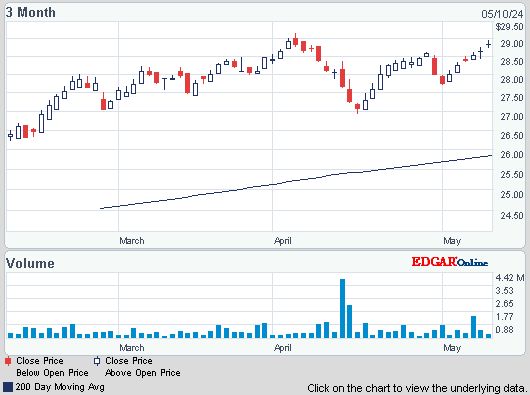Dow jumped 130, advancers over decliners 2-1 & NAZ added 31. The MLP index was up 1+ to 440 & the REIT index did little, hanging in just above 260. Junk bond funds hardly moved & Treasuries advanced. Oil & gold were higher.
AMJ (Alerian MLP Index tracking fund)

US industrial production climbed in Nov by the most in a year. Output at factories, mines and utilities rose 1.1% after a revised 0.1% gain in Oct that was previously reported as a decline, according to the Federal Reserve. The forecast called for a 0.6% increase. The index of industrial production rose to 101.3, exceeding for the first time its pre-recession peak in Dec 2007. Manufacturing rose by the most in 3 months, indicating factories are getting a boost from a rebound in domestic demand & pickups in some overseas markets such as Europe & China. Sustained gains in the labor market will help propel consumer spending, supporting the industry into 2014. Manufacturing, 75% of total production, advanced 0.6% last month after rising a revised 0.5% in Oct. The back-to-back increases were the strongest this year. Factories produced more consumer goods, materials & construction supplies last month. Utility output increased 3.9% after declining 0.3% in Oct as falling temperatures prompted Americans to adjust their thermostats last month. Mining output, which includes oil drilling, increased 1.7%, the most since Oct 2011.
Industrial Production in U.S. Increases 1.1%, Most in a Year
Mario Draghi, testified before the European Parliament's Committee on Economic & Monetary Affairs. "We have several other instruments on the liquidity front and so we don't feel that we are short of instruments. In the meantime, we continue to reflect on the array of instruments that we can mobilize if further risks were to materialize." "We don't see deflation in the sense that's defined as a self-fulfilling drop in prices." "We don't see a generalized fall in prices across commodities and countries." "We continue to expect ECB key interest rates to remain at present or lower levels for an extended period of time. Thus, monetary policy will remain accommodative for as long as necessary." "Excess liquidity in overnight money markets has been gradually receding. We are monitoring the potential impact of these developments on our monetary policy stance. We are ready to consider all available instruments." "We are fully aware of the downward risks that a protracted period of low inflation entails. Consistent with its forward guidance, the Governing Council is ready and able to act if needed."
US crude oil production will approach a record by 2016, climbing to the highest level in 46 years as rising output from shale formations lifts domestic supplies, reducing the nation’s need for foreign oil. Domestic output will grow annually by 0.8M barrels a day to 9.5M in 2016, nearing the record level of 1970, according to the US Energy Information Administration’s (EIA) Annual Energy Outlook for 2014. Natural gas production will grow 56% to 37.6T cubic feet by 2040, boosting liquefied natural gas exports to 3.5T, EIA said. The report “shows that advanced technologies for crude oil and natural gas production are continuing to increase domestic supply and reshape the US energy economy, as well as expand the potential for natural gas exports,” the EIA said. US oil production grew 18% in the past 12 months, according to the EIA, as the combination of horizontal drilling & hydraulic fracturing, or fracking, unlocked supplies trapped in shale formations. The US pumped 8.975M barrels a day of oil in the week last week, the most since Oct 1988, while the nation’s refiners operated at 92.6% of capacity, the highest level for the time of year since 2004, the EIA said. The boom, which has reduced the nation’s reliance on imports, will make the country the world’s largest producer by 2015, 5 years sooner than last year’s forecast. Taking into account all energy sources, including natural gas, petroleum, nuclear & renewables, the US met 86% of its needs in the first 8 months of 2013, on pace to be the highest annual rate since 1986.
U.S. Crude Oil Output Will Climb Toward Record by 2016, EIA Says
Stocks are having a good day as buyers liked the economic data. But yield sensitive securities remain under pressure, weighed down by concerns about tapering at the Fed.meeting this week. For example, the REIT index is down 55 from the highs reached earlier this year. Today's market advance masks that all is not well in the stock market.
AMJ (Alerian MLP Index tracking fund)
Treasury yields:
U.S. 3-month |
0.07% | |
U.S. 2-year |
0.33% | |
U.S. 10-year |
2.84% |
| CLF14.NYM | ...Crude Oil Jan 14 | ...97.24 | (0.7%) |
| GCZ13.CMX | ...Gold Dec 13 | ....1,236.30 | (0.1%) |
US industrial production climbed in Nov by the most in a year. Output at factories, mines and utilities rose 1.1% after a revised 0.1% gain in Oct that was previously reported as a decline, according to the Federal Reserve. The forecast called for a 0.6% increase. The index of industrial production rose to 101.3, exceeding for the first time its pre-recession peak in Dec 2007. Manufacturing rose by the most in 3 months, indicating factories are getting a boost from a rebound in domestic demand & pickups in some overseas markets such as Europe & China. Sustained gains in the labor market will help propel consumer spending, supporting the industry into 2014. Manufacturing, 75% of total production, advanced 0.6% last month after rising a revised 0.5% in Oct. The back-to-back increases were the strongest this year. Factories produced more consumer goods, materials & construction supplies last month. Utility output increased 3.9% after declining 0.3% in Oct as falling temperatures prompted Americans to adjust their thermostats last month. Mining output, which includes oil drilling, increased 1.7%, the most since Oct 2011.
Industrial Production in U.S. Increases 1.1%, Most in a Year
Mario Draghi, testified before the European Parliament's Committee on Economic & Monetary Affairs. "We have several other instruments on the liquidity front and so we don't feel that we are short of instruments. In the meantime, we continue to reflect on the array of instruments that we can mobilize if further risks were to materialize." "We don't see deflation in the sense that's defined as a self-fulfilling drop in prices." "We don't see a generalized fall in prices across commodities and countries." "We continue to expect ECB key interest rates to remain at present or lower levels for an extended period of time. Thus, monetary policy will remain accommodative for as long as necessary." "Excess liquidity in overnight money markets has been gradually receding. We are monitoring the potential impact of these developments on our monetary policy stance. We are ready to consider all available instruments." "We are fully aware of the downward risks that a protracted period of low inflation entails. Consistent with its forward guidance, the Governing Council is ready and able to act if needed."
ECB's Draghi speaks at European Parliament
US crude oil production will approach a record by 2016, climbing to the highest level in 46 years as rising output from shale formations lifts domestic supplies, reducing the nation’s need for foreign oil. Domestic output will grow annually by 0.8M barrels a day to 9.5M in 2016, nearing the record level of 1970, according to the US Energy Information Administration’s (EIA) Annual Energy Outlook for 2014. Natural gas production will grow 56% to 37.6T cubic feet by 2040, boosting liquefied natural gas exports to 3.5T, EIA said. The report “shows that advanced technologies for crude oil and natural gas production are continuing to increase domestic supply and reshape the US energy economy, as well as expand the potential for natural gas exports,” the EIA said. US oil production grew 18% in the past 12 months, according to the EIA, as the combination of horizontal drilling & hydraulic fracturing, or fracking, unlocked supplies trapped in shale formations. The US pumped 8.975M barrels a day of oil in the week last week, the most since Oct 1988, while the nation’s refiners operated at 92.6% of capacity, the highest level for the time of year since 2004, the EIA said. The boom, which has reduced the nation’s reliance on imports, will make the country the world’s largest producer by 2015, 5 years sooner than last year’s forecast. Taking into account all energy sources, including natural gas, petroleum, nuclear & renewables, the US met 86% of its needs in the first 8 months of 2013, on pace to be the highest annual rate since 1986.
U.S. Crude Oil Output Will Climb Toward Record by 2016, EIA Says
Stocks are having a good day as buyers liked the economic data. But yield sensitive securities remain under pressure, weighed down by concerns about tapering at the Fed.meeting this week. For example, the REIT index is down 55 from the highs reached earlier this year. Today's market advance masks that all is not well in the stock market.











No comments:
Post a Comment